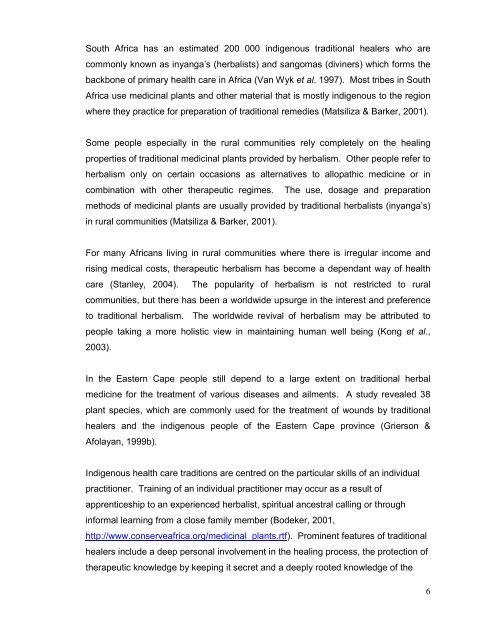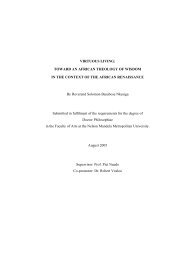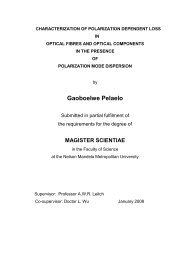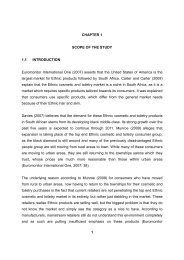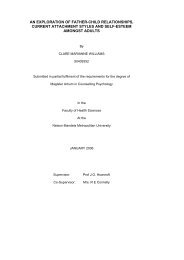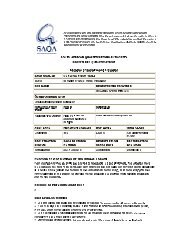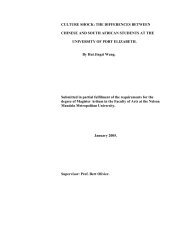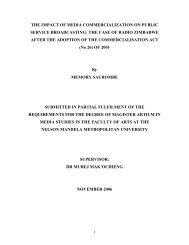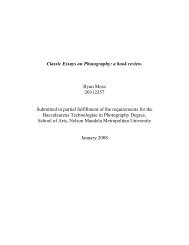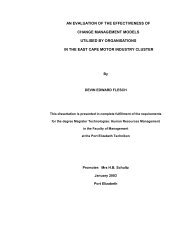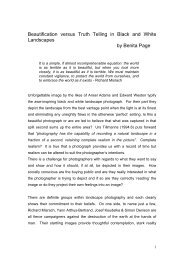an investigation into the antibacterial activities of medicinal plants ...
an investigation into the antibacterial activities of medicinal plants ...
an investigation into the antibacterial activities of medicinal plants ...
You also want an ePaper? Increase the reach of your titles
YUMPU automatically turns print PDFs into web optimized ePapers that Google loves.
South Africa has <strong>an</strong> estimated 200 000 indigenous traditional healers who are<br />
commonly known as iny<strong>an</strong>ga’s (herbalists) <strong>an</strong>d s<strong>an</strong>gomas (diviners) which forms <strong>the</strong><br />
backbone <strong>of</strong> primary health care in Africa (V<strong>an</strong> Wyk et al. 1997). Most tribes in South<br />
Africa use <strong>medicinal</strong> pl<strong>an</strong>ts <strong>an</strong>d o<strong>the</strong>r material that is mostly indigenous to <strong>the</strong> region<br />
where <strong>the</strong>y practice for preparation <strong>of</strong> traditional remedies (Matsiliza & Barker, 2001).<br />
Some people especially in <strong>the</strong> rural communities rely completely on <strong>the</strong> healing<br />
properties <strong>of</strong> traditional <strong>medicinal</strong> pl<strong>an</strong>ts provided by herbalism. O<strong>the</strong>r people refer to<br />
herbalism only on certain occasions as alternatives to allopathic medicine or in<br />
combination with o<strong>the</strong>r <strong>the</strong>rapeutic regimes. The use, dosage <strong>an</strong>d preparation<br />
methods <strong>of</strong> <strong>medicinal</strong> pl<strong>an</strong>ts are usually provided by traditional herbalists (iny<strong>an</strong>ga’s)<br />
in rural communities (Matsiliza & Barker, 2001).<br />
For m<strong>an</strong>y Afric<strong>an</strong>s living in rural communities where <strong>the</strong>re is irregular income <strong>an</strong>d<br />
rising medical costs, <strong>the</strong>rapeutic herbalism has become a depend<strong>an</strong>t way <strong>of</strong> health<br />
care (St<strong>an</strong>ley, 2004). The popularity <strong>of</strong> herbalism is not restricted to rural<br />
communities, but <strong>the</strong>re has been a worldwide upsurge in <strong>the</strong> interest <strong>an</strong>d preference<br />
to traditional herbalism. The worldwide revival <strong>of</strong> herbalism may be attributed to<br />
people taking a more holistic view in maintaining hum<strong>an</strong> well being (Kong et al.,<br />
2003).<br />
In <strong>the</strong> Eastern Cape people still depend to a large extent on traditional herbal<br />
medicine for <strong>the</strong> treatment <strong>of</strong> various diseases <strong>an</strong>d ailments. A study revealed 38<br />
pl<strong>an</strong>t species, which are commonly used for <strong>the</strong> treatment <strong>of</strong> wounds by traditional<br />
healers <strong>an</strong>d <strong>the</strong> indigenous people <strong>of</strong> <strong>the</strong> Eastern Cape province (Grierson &<br />
Afolay<strong>an</strong>, 1999b).<br />
Indigenous health care traditions are centred on <strong>the</strong> particular skills <strong>of</strong> <strong>an</strong> individual<br />
practitioner. Training <strong>of</strong> <strong>an</strong> individual practitioner may occur as a result <strong>of</strong><br />
apprenticeship to <strong>an</strong> experienced herbalist, spiritual <strong>an</strong>cestral calling or through<br />
informal learning from a close family member (Bodeker, 2001,<br />
http://www.conserveafrica.org/<strong>medicinal</strong>_pl<strong>an</strong>ts.rtf). Prominent features <strong>of</strong> traditional<br />
healers include a deep personal involvement in <strong>the</strong> healing process, <strong>the</strong> protection <strong>of</strong><br />
<strong>the</strong>rapeutic knowledge by keeping it secret <strong>an</strong>d a deeply rooted knowledge <strong>of</strong> <strong>the</strong><br />
6


